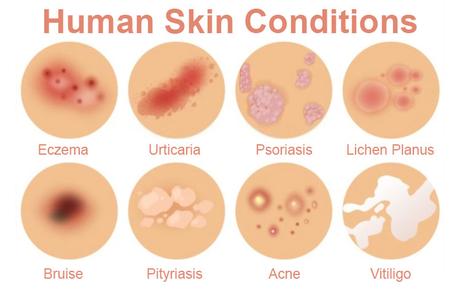
Millions of people around the world suffer from some form of skin condition. These range from mild redness and itching to more serious problems such as acne, boils, and eczema. Some conditions are temporary, such as pimples caused by an increase in oils secreted by our sebaceous glands. Other conditions are chronic and can be painful or even life-threatening if left untreated. Understanding what causes these conditions is important because early intervention is key in preventing them from escalating or recurring. Many skin conditions have no known explanation, while others may be triggered by exposure to the sun (sunburn) or reactions to certain environmental factors, including humidity, stress, and diet. Skin conditions are also often directly related to genetics and heredity. Here we take a look at some of the most common skin conditions:
Acne
Acne is the most common skin condition, affecting millions of people around the globe, especially during puberty when our hormones are at their peak. The acne is caused by increased sebum production, which leads to inflammation of the sebaceous glands. There are several types of acne, including blackheads and whiteheads, comedones, papules, pustules, and cysts. Blackheads and whiteheads are caused by a build-up of oil under the skin, sebum, that oxidizes when exposed to air. Comedones are a form of acne that appears as a “pimple” under the skin. Papules are small and red, while pustules are caused by a bacterial infection and are red with a white center. Cysts are larger, painful lumps under the skin. Acne can be treated with over-the-counter remedies or prescription medications.
Dry Skin
Dry skin can be caused by several factors. It may be caused by a change in the season when the weather is particularly hot or cold. It may also be caused by excessive washing or bathing, which strips the skin of its natural oils. Dry skin is treated by moisturizing. Some people are advised to use mild soap, while others find that they do not need to wash their faces at all. Cosmetics and moisturizers can also help reduce dryness.
Boils & Carbuncles
Boils are bacterial infections that appear as painful lumps under the skin. Carbuncles are larger and more serious, caused by a bacterial infection that spreads beyond a single boil to an entire patch of skin. Both can be treated with antibiotics but may recur if the cause is not discovered. Cleansing the skin regularly, keeping it dry, and avoiding bacterial infection are ways to prevent boils and carbuncles.
Eczema
Eczema is a non-contagious, itchy skin condition that often affects children but can also affect adults. It is caused by a hypersensitivity to certain allergens. There are two types of eczema: localized and general. General eczema is widespread and can be triggered by allergies, stress, and even emotions such as anger and frustration. Treatments include cleaning the skin regularly, avoiding triggers, and reducing stress. There are several products on the market that are designed specifically for people with eczema. These include creams and ointments, as well as socks and gloves that are designed to protect the skin from scratching.
psoriasis
Psoriasis is a chronic and itchy skin condition that causes scaly red patches on the skin. It is caused by a build-up of skin cells that are produced too quickly. It is more common in people with a family history of psoriasis. There are many treatment options for psoriasis, including topical medicines, phototherapy, and even surgery to remove the scaly patches.
Rosacea
Rosacea is a common skin condition that affects the face and has many symptoms, including redness, inflammation, acne, and itching. It is not known what causes rosacea and it is not contagious. There are several treatments available, including topical creams that control inflammation, antibiotics, and oral contraceptives.
Seeking Professional Help
While some skin conditions may be obvious or have been experienced previously, it’s always best practice to see a medical professional, whether that’s your doctor, or a dermatologist, who specialist in the diagnosis and treatment of skin conditions.
Conclusion
Skin conditions affect millions of people around the world and can be triggered by many factors. They can range from mild to severe, and treatment options vary depending on the diagnosis, from over-the-counter medication to prescription medication. It’s always best to consult with a medical professional before seeking remedies.

